- Home
- Carl Sagan
Comet Page 17
Comet Read online
Page 17
All right, so a molecule of CO, let’s say, scurries off the cometary nucleus into space, and is mugged by a light beam, losing an electron in the scuffle. Why should it now move straight back from the Sun? Why should the knots in the ions tails accelerate erratically? What emanation from the Sun does an ion see that a dust grain doesn’t?
Radiation pressure is far too feeble to explain the acceleration of knots in the ion tail. Also, the acceleration of the knots varies with time, while the light put out by the Sun is extremely steady. There must be some other means besides the light it radiates to space, by which the Sun can affect the tails of comets. If we study the knots over a period of months, we sometimes find a periodicity in the accelerations closely equal to the period of rotation of the Sun as seen from the comet. The conclusion is straightforward: the influence emanates from a particular region on the Sun, not from the Sun as a whole. The influence, whatever it is, reaches out to the comet only when the active solar region is oriented cometward. As the Sun rotates (once every 27 days, as seen from the Earth), the active region on the Sun eventually faces away from the comet, and the ion tail acceleration subsides, only to revive again as the region rotates around again.
Left: Five photographs taken approximately an hour apart of Comet Whipple-Fedtke-Tevzadze (1943 I) on March 8/9, 1943. Photographed in wartime Nazi Germany by C. Hoffmeister, Sonneberg Observatory. From N. B. Richter, The Nature of Comets (Methuen, 1963). Right: Forms of comets, drawn according to Pliny’s written description. From Amédée Guillemin, The World of Comets (Paris, 1877).
It has long been known that the Sun episodically emits charged particles: A flare on the surface of the Sun is seen through the telescope and three days later a “magnetic storm” strikes the Earth, interfering with long-distance radio communications. Fortuitously, on March 29, 1943, the ion tail of Comet Whipple-Fedtke-Tevzadze exhibited a marked knot acceleration, and on the same day a major magnetic storm reached the Earth. From such observations, the astrophysicist Ludwig Biermann, working in Germany during and after World War II, calculated the properties of these bursts of charged particles from the Sun. His conclusion was that there must be a steady solar wind that blows outward from the Sun at all times, and that drives the ion tails of comets leeward no matter what section of the sky the comet happens to be in. But in addition, the episodic accelerations in the ion tails must be due to something else, now known to be enhancements to the solar wind pouring out of holes in the Sun’s corona and sharing the Sun’s rotation.
The solar wind was first directly detected by the Soviet Luna 3 spacecraft in 1959, and later by the American spacecraft Explorer 10 and, especially, the interplanetary spacecraft Mariner 2 on its historic first voyage from Earth to Venus in 1962. The measurements showed that the solar wind consisted mainly of protons and electrons. There were only a few of them per cubic centimeter in the vicinity of the Earth, but they were rushing radially outward from the Sun at speeds of several hundred kilometers per second. Faster, higher density gusts were also found. In addition, occasional flares and other violent events on the Sun’s surface propel globs of high energy protons and electrons out into space. This wind from the Sun carries with it a magnetic field that sweeps up ions in its path. The moment a molecule is ionized by sunlight, it is captured by the magnetic fields carried with the solar wind. However, those molecules that are not ionized, that remain electrically neutral, are unaffected by magnetic fields. Thus the ion tails of comets are weather vanes in the solar wind, always blowing straight back; but occasionally an irregular magnetized cloud from the Sun catches up with the tail and stirs up the ions.
The ion tail has more variability and often more structure than the dust tail. In a period of hours the thin, straight rays can change, merge, and dissipate. Evanescent features take complex forms, including sharp, right-angle discontinuities and corkscrew shapes millions of kilometers across. Some of the tail patterns look almost as if the comet is veering erratically, like smoke bombs on the Fourth of July. But the comet is moving on an almost perfect elliptical orbit; the solar wind is responsible for the patterns. Sometimes the entire tail disconnects itself from the nucleus and, fading, drifts slowly back until it disappears entirely. Typically, the nucleus forms a new tail after a disconnection event, and the old and the new tail may interact or even become briefly intertwined. The complexity and variability of the tails of comets has an almost biological feel to it. The prevailing opinion among astronomers is that the interaction of the electrically charged molecules in the ion tail with the highly variable solar wind accounts for most of the strange behavior of comet tails. The comet, of course, contributes some idiosyncrasies of its own—as, for example, the timing and magnitude of gas and dust outbursts. But, in detail, we are still far from understanding the changing forms in the ion tails of comets.
Comet Mrkos photographed August 3, 1957, with the 48-inch Schmidt telescope at Mount Palomar Observatory. Note the structureless faint dust tail and the extremely complex morphology of the ion tail.
Comet Humason (1962 VIII). Note the ray structure. Mount Palomar Observatory photograph. Courtesy National Aeronautics and Space Administration.
Astronomers spend long hours arranging photographs of the same cometary tail in their proper time sequence, and—with equipment ranging from a magnifying glass to a computer contrast enhancement system—examining every burp and wiggle in hopes of uncovering the underlying physical mechanisms. Since the flow of charged and neutral gases through a moving stream of protons carrying its own magnetic field is not something we often run into in our everyday lives, the subject is necessarily arcane. It involves elaborate three-dimensional magnetohydrodynamic calculations, and laboratory simulations in which electrically charged plasma interacts with some solid object (for example, a ball of wax) intended to duplicate the cometary nucleus.
The motion of comets in the Sun’s gravitational field involves essentially the same physics as a rock thrown up into the air and falling back to the ground. There is a ready parallel in everyday life. The vaporization of ice off a cometary nucleus and into the interplanetary vacuum is not very different from the evaporation of snow into the Earth’s atmosphere on a sunny day. Again, we easily understand the phenomenon because it is part of everyday life. But—beyond a distant relationship to the aurora borealis—the plasma physics of cometary tails does not have a ready terrestrial analogue, so naturally it presents to us facets that are mysterious, that tend to resist our attempts to understand. However, as a result, comet tails are natural laboratories in which we can test our understanding of plasma physics.
Our knowledge of the ion tails of comets is new and in certain respects still tentative, but it fully satisfies the expectations of astronomers of an earlier epoch. The American astronomer E. E. Barnard wrote in 1909:
In any attempt to explain certain of these features of the comet, we are forced to tread on very dangerous ground, for there is nothing in the adopted theories of comets that will explain them, and we must assume unknown quantities that perhaps violate all our ideas of the conditions existing in space in the vicinity of the Sun and planets. But, as there seems to be no other explanation, the very fact that we are driven to extremes in the search for a possible cause may lead to a knowledge of interplanetary conditions that would never become known without the aid of the wide sweeping tail of a comet.
Today we understand that the ion tails are solar wind socks, probes of interplanetary weather conditions which might otherwise escape our notice altogether.
After a comet begins to outgas and a coma forms, the solar wind and the magnetic field it carries collide with the cometary atmosphere. Molecules in the outer layers of the coma are ionized by ultraviolet light from the Sun. The solar wind sweeps these ions up, flows around the sunward segment of the coma, and carries the ions far downwind. A shock wave is created, similar to that in front of a high performance aircraft when it reaches supersonic speeds. This bow shock is established as much as a million kilometers
windward of the comet. The ions whipped leeward by the solar wind may stretch out a hundred million kilometers away from the Sun, pumped to glow an eerie blue by sunlight. Occasionally, the tail is overtaken by a gust and more rarely by a small cyclone in the solar wind, and havoc is wrought in a tail that formerly stretched perfectly radially out from the Sun.
Because of their rapid and erratic variability, and technical and organizational limitations, there had never been an adequate time lapse motion picture of a comet tail. But now we have reached the point when this is possible, both from the ground and from spacecraft. Even color stereoscopic movies are now possible. Moreover, there are today a number of monitoring stations in interplanetary space that are routinely surveying the solar wind and its variations. We are now nearly ready to employ our knowledge of interplanetary weather in a comprehensive understanding of the long and graceful tails of comets.
CHAPTER 10
A Cometary Bestiary
If a rare [comet] and one of unusual shape appears, everyone wants to know what it is and, ignoring the other celestial phenomena, asks about the newcomer, uncertain whether he ought to admire or fear it. For there is no lack of people who create terror and predict dire meanings.
—SENECA, NATURAL QUESTIONS BOOK 7, “COMETS”
The astronomers … give more attention to the lows of their movements than to the strangeness of their form.
—IMMANUEL KANT, ON COMETS,
GENERAL NATURAL HISTORY AND THEORY OF THE HEAVENS, 1755
Like a breaching whale before it plunges into the ocean depths, a comet briefly luxuriates in the sunlight and then is gone. The comets dance in the night sky, capriciously altering brightness, size, and form. Sometimes we make out extraordinary activity near the nucleus. Halos are produced, shed, and dissipated. Multiple fountains can be seen spraying gas and dust into space. Because a comet typically rotates once every few hours, the curvature of the streamers is marked. Everything is blown back from the Sun by radiation pressure and the solar wind.
Some comets propel a clockwork succession of shroudlike comas into space. Comet Donati is a famous example. The most ready explanation is that there is a patch of surface ice which explosively evaporates in sunlight; since the comet is rotating, a typical patch sees both night and day, and new comas are generated on the sunlit side once each rotation.
On these pages we have accumulated a kind of cometary bestiary, like the animal bestiaries assembled by medieval authors to amaze and delight, and even to instruct. Most of the animals displayed were real; many were exotic; a few, such as the unicorn, were the result of errors in transmission, garbled accounts—in this case, of the African rhinoceros. There were also some conscious hoaxes. We look back at the bestiaries with fondness, and perhaps a little amusement, recognizing that they are the forerunners of modern textbooks in zoology.
In a similar spirit, we offer here a range of images, photographed or drawn at the telescope, of the forms of comets; particular attention is paid to the jets within the comas. Sometimes the comet presents itself so that we are looking down the axis of rotation; other times, we are viewing obliquely. In all cases, it is easy to tell where the Sun lies. The illustrations are reproduced black on white, to heighten contrast.
At the telescope, the astronomer is peering through an ocean of turbulent air, and the image produced is always distorted. One of the reasons that telescopes are located on isolated mountain tops, above much of the atmosphere, is to improve the seeing. At the focus of a large telescope, the astronomer’s eye has a great advantage over the photographic plate: the astronomer can recall how, just a moment ago, the atmosphere steadied and fine detail in the comet could be glimpsed. By remembering such moments and drawing what was seen, the astronomer can often produce detail inaccessible to a camera attached to the same telescope. But the disadvantage of this method is that people are imperfect recording devices, and at the limit of resolution the eyes can play tricks. Nevertheless, by comparing the drawings of independent observers, by matching drawings with photographs, and by new image enhancement techniques, it is possible to verify that, by and large, the early cometary observers knew what they were doing.
Every one of these cometary forms represents a snapshot of the life and death of a comet, a glimpse of sunlight doing violence to a large lump of ice. Each of these displays is produced, at least in part, by streamers of gas and dust, rotation, radiation pressure, and the local weather conditions in the solar wind. The streamers and the coma are typically thousands of kilometers across, or more. Deducing the underlying events from the appearances left is what detectives do. It is also what field geologists do. Let your eye roam over the variety of cometary forms exhibited here, and see if you can construct a plausible explanation of what is happening in each case.
The comet as depicted in a variety of different ages and cultures. Painting by Anne Norcia. For a detailed key see facing page.
Comets as depicted in many cultures: (A) Chinese painting on silk, 168 B.C. (B) From the Bayeux Tapestry, recording the appearance of Halley’s Comet in spring 1066. (C) From the Eadwine Psalter, illuminated manuscript on vellum, ca. 1145, by the monk Eadwine, based on accounts of Halley’s Comet that appeared around this date. (D) From the fresco The Adoration of the Magi by Giotto, ca. 1304. The gold pigments have been lost, revealing the red adhesive by which they were applied to the plaster. (E) From the Nuremberg Chronicles, a woodblock illustration published in 1493. It recounts the appearance of Halley’s Comet in 684. (F) An Aztec depiction of a bright comet seen by the Emperor Moctezuma II in the 1500s. From Historia de las Indias de Nueva España by Diego Duran. (G) A Turkish representation of the Great Comet of 1577. (H) A comet form according to Pliny, taken from Hevelius’ Cometographie, 1640–80s. (I) One of several comet forms shown in Hevelius’ Cometographie, 1640–80s. (J) Detail of a probable comet from the hand guard in a Japanese wrought-iron sword with pierced design, Tsuba, c. 1700. (K) Illustration based on Halley’s Comet photograph obtained in May 1910. From the Southern Observing Station of the Lick Observatory on Cerro San Cristóbal in Santiago, Chile. (L) Comet Bradfield, observed at approximately 1700 Greenwich Mean Time on January 10, 1980. Illustration computer enhanced by Goddard Space Center.
Below, we are looking obliquely at a nucleus while five or six streamers are being blown back by the Sun. On this page we see that the fountains are restricted to the heated sunward hemisphere of the cometary nucleus. The direction of rotation can often be deduced from the curvature of the streamers.
Five (or possibly six) jets off the nucleus of Comet Tebbutt (1861 II), drawn by Schmidt. Courtesy National Aeronautics and Space Administration.
In the drawing below, we are looking obliquely at the multiple fountains of dust erupting from the day side of the Great Comet of 1861. But imagine that instead the comet had approached the Earth from behind, its pole by accident pointed in our direction. Then we would be looking straight down on the axis of rotation, and the pinwheel of fountains would be rotating as we watched. This seemed to be the case with comet Hale-Bopp in late 1996.
Multiple fountains playing off the sunward side of the nucleus of the Comet of 1861. Drawn by Warren de la Rue, July 2, 1861. From Amédée Guillemin, The Heavens (Paris, 1868).
The thought suggests itself that the curves [in tail streamers] may be spiral curves produced by a rotation of the nucleus of the comet whilst it is discharging the streamers.
—ARTHUR STANLEY EDDINGTON
Fortunately, the Earth’s gravity is insufficient to drag passing comets to us. But every now and then, by chance, a comet will make a close pass by the Earth. It is only a matter of waiting. If you can wait long enough—a hundred million years, say—you are likely to see even very odd comets. For example, between the orbit of Saturn and Uranus is Chiron, a highly unusual object discovered in 1977 by Charles Kowal of the Hale Observatories in California. Named after the centaur who taught Jason and Achilles, Chiron is three or four hundred kilometers across, bigger than any kn
own comet, although it is no larger than the bigger asteroids. Could it be the most visible member of a previously unknown population of massive comets that live mainly beyond Pluto? In the 1990s a large population of such objects—sometimes called the Centaur asteroids—began to be discovered. Chiron is dark. Other Centaur objects—one called Pholus, for example—are dark and red. The reflection properties of Pholus seem compatible only with a surface covered by complex organic matter. Perhaps these worlds are comets whose surface ices of methane and other exotic volatiles have evaporated leaving a dark organic matrix behind.
An early composite digitalized image of Comet Hale-Bopp, taken by an amateur astronomer using charge coupled device technology; showing multiple jets in various directions, many of them probably due to the vaporization of different ices. Tim Puckett, Puckett Observatory, September 1996.
Every few thousand years, Chiron makes a sufficient number of distant passes by Saturn that its orbit is considered unstable. It may be slowly working its way in toward the Sun, and may one day become a short-period comet. Imagine, then, after repeated encounters with Saturn and Jupiter, that Chiron one day enters the inner solar system. If Comet Schwassmann-Wachmann 1 can still produce outbursts from its lonely post between the orbits of Jupiter and Saturn, if the Great Comet of 1729 could be visible to the naked eye when it was almost at the distance of Jupiter, then what would an object like Chiron look like if it were newly arrived from the outermost solar system and making a close pass by the Earth? Very likely, there is water ice present that would explosively evaporate as Chiron approached the Sun. A very dark comet, perhaps perceptibly red, hundreds of kilometers across, with multiple dust fountains and an immense tail, would be quite a spectacle as it passed by the Earth. There does not seem to be any historical record of such an apparition. It is doubtless a rare event.

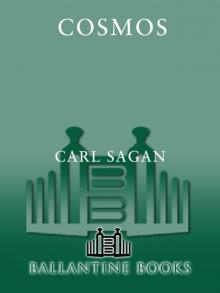 Cosmos
Cosmos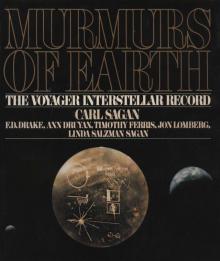 Murmurs of Earth
Murmurs of Earth Broca's Brain
Broca's Brain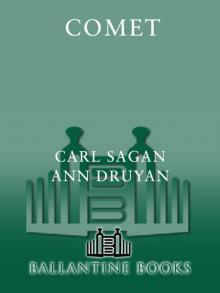 Comet
Comet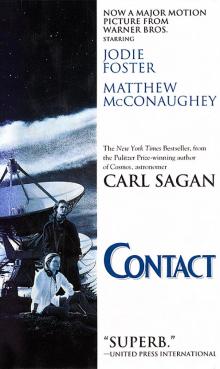 Contact
Contact Dragons of Eden
Dragons of Eden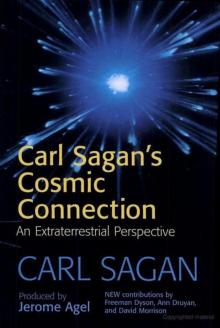 Cosmic Connection
Cosmic Connection Shadows of Forgotten Ancestors
Shadows of Forgotten Ancestors Billions & Billions
Billions & Billions Comet, Revised
Comet, Revised Broca's Brain: The Romance of Science
Broca's Brain: The Romance of Science The Varieties of Scientific Experience: A Personal View of the Search for God
The Varieties of Scientific Experience: A Personal View of the Search for God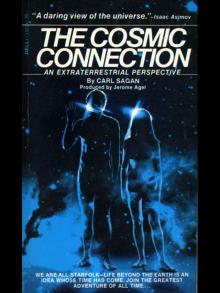 The Cosmic Connection
The Cosmic Connection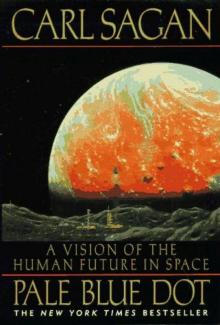 Pale Blue Dot: A Vision of the Human Future in Space
Pale Blue Dot: A Vision of the Human Future in Space The Dragons of Eden
The Dragons of Eden